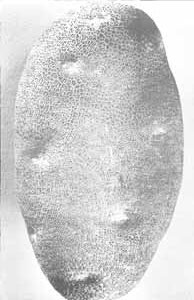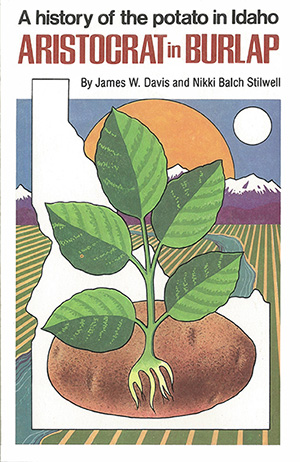 The Russet Burbank is elongated with rough skin.
The Russet Burbank is elongated with rough skin.
There appears to be no reason to doubt that Russet Burbank variety originated as a periclinalsomatic mutation or sport of the Burbank variety as selected by Luther Burbank in the summer of 1873 from 23 seedlings derived from a chance fruit on a plant of Early Rose variety.
Luther Burbank, in his writings, has stated that this chance seedling constituted his first commercially valuable plant development and that it furnished a practical means of his moving to California where he was able to carry out his experiments on a far more-comprehensive scale than would have been possible in his native New England.
Burbank gained his great renown from his subsequent work in plant hybridization, not from the potato bearing his name. In retrospect, considering the importance of the Russet Burbank potato variety in present-day agriculture and industry, the Burbank and subsequent Russet Burbank mutant would appear to be his greatest single accomplishment.
Even though the Burbank strain was developed in New England and mutated in Colorado, it remained for Idaho growers to make the variety famous. Potato scientists have speculated that it was not the Russet Burbank that made Idaho famous, but rather Idaho that made the Russet Burbank famous. The rationale for this statement is based on the fact that Idaho growing conditions tend to produce a superior potato of any variety.
Since potatoes were originally a high-altitude plant, they tend to grow better at elevations somewhat above sea level. Summer days along the Snake River Valley in Idaho are sunny and warm. Photosynthesis creates carbohydrates in the green leaves of potato vines in the form of starch. However, the leaves cannot store the starch and a process called translocation takes place. This action requires cool temperatures between sunset and sunrise for the successful transfer of the starch from leaves to tubers. Idaho's climate of warm days and cool nights provides ideal climatic conditions for the growing and production of potatoes.
In addition to climate, potatoes require high moisture content in the soil. It is thought that the ideal water content is around 80 percent. Most areas where there is sufficient sunshine to grow a good crop of potatoes do not have rainfall providing frequent rainstorms to maintain the solid moisture at the ideal level. Since nearly all of South Idaho agriculture depends on irrigation, it is possible for growers to regulate the amount of water and the soil moisture content at the ideal level.


 The Russet Burbank is elongated with rough skin.
The Russet Burbank is elongated with rough skin.